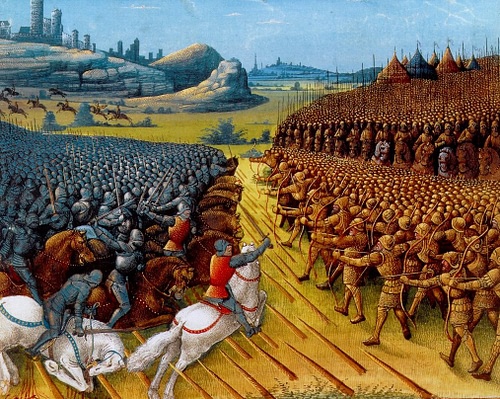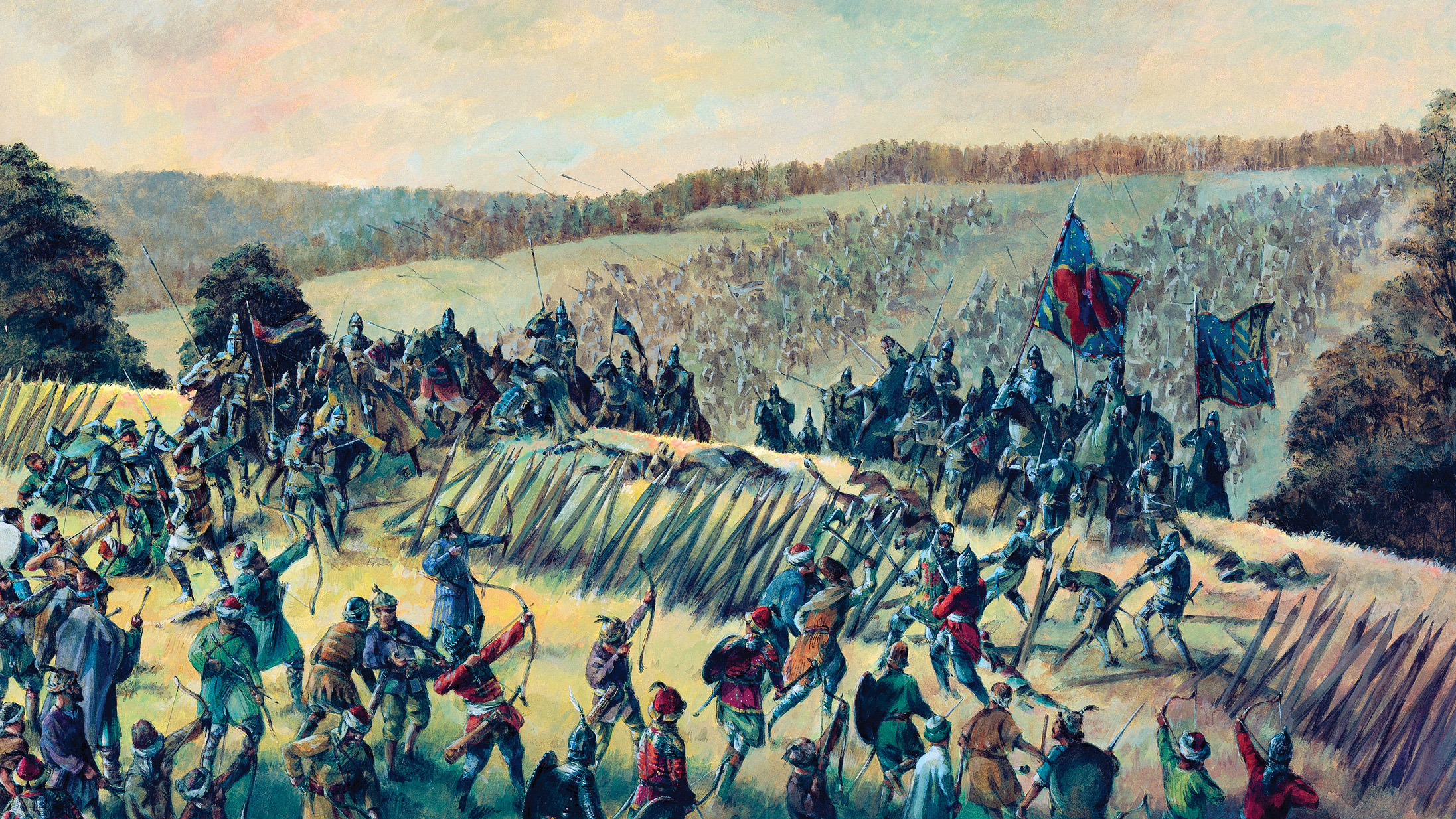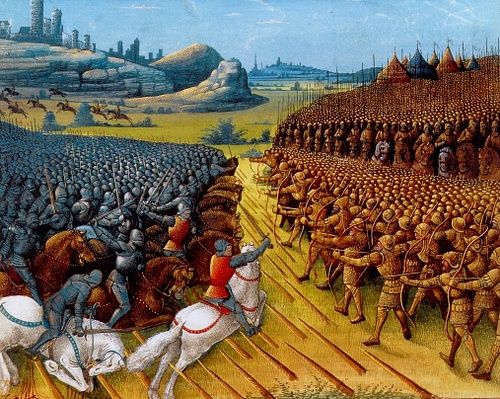The historical Battle of Nicopolis, fought on September 25, 1396, stands as a pivotal event in the context of the late medieval world. This confrontation marked the culmination of the final significant Crusade endeavor, resulting in the defeat of an allied Crusader army by the formidable forces of the Ottoman Empire. The aftermath of this battle not only hastened the decline of the Second Bulgarian Empire but also discouraged European coalitions against the Ottomans, thereby reshaping the power dynamics in the region.
The article explores the intricate historical context that led to this event, highlighting the political fragmentation in Europe, significant internal conflicts such as the Hundred Years War, and the Papal call for a Crusade spearheaded by Pope Boniface IX. With an examination of the strategic blunders, the composition of the opposing forces, and the battle’s outcome, this discourse provides a comprehensive overview of how the Battle of Nicopolis underscored the rising threat of the Ottoman Empire in Central Europe, while simultaneously dismantling hopes for a united Christian front against it.
Historical Background of the Crusades
Origins of the Crusades
The Crusades were a series of religious and military campaigns originating from Europe, primarily in response to the rapid expansion of Muslim territories in the Holy Land. The term “Crusade” derives from the Latin “crux,” meaning “cross,” symbolizing the Christian motivation to reclaim sacred sites. The First Crusade, initiated in 1095, was marked by Pope Urban II’s call to arms, which aimed to assist the Byzantine Empire and reclaim Jerusalem from Muslim rule. This period represented a significant intersection of religion, politics, and warfare, revealing how deeply interwoven faith and power were in medieval Europe.
Major Crusades before 1396
Prior to the Battle of Nicopolis in 1396, several significant Crusades unfolded, each reflecting evolving objectives and changing dynamics within European and Islamic territories. The First Crusade (1096-1099) achieved remarkable success, culminating in the capture of Jerusalem. Subsequent efforts, such as the Second Crusade (1147-1150) and the Third Crusade (1189-1192), were marked by both notable victories and defeats, with leaders like Richard the Lionheart facing Saladin’s forces. The Fourth Crusade (1202-1204) proceeded disastrously for Christian unity, as crusaders diverted to sack Constantinople, undermining the initial purpose of liberating the Holy Land. By the time of the late 14th century, a sense of fatigue surrounded Crusading efforts, as political disarray and changing cultural attitudes in Europe contributed to diminishing enthusiasm for such large-scale religious warfare.
Decline of Crusading Spirit in Europe
By the late 14th century, the Crusading zeal that characterized the earlier medieval period had waned significantly. This decline was exacerbated by ongoing internal conflicts in Europe, such as the Hundred Years War between England and France, which diverted resources and attention from external threats. Additionally, the consolidation of the Ottoman Empire in the Balkans further complicated European politics; the once cohesive Christian front fractured into competing interests. The papacy’s calls for renewed Crusades, such as that of Pope Boniface IX in 1394, were met with mixed reactions as European monarchs hesitated, balancing their local incentives against the looming Ottoman threat.
The Ottoman Empire in the Late 14th Century
Expansion of Ottoman Territory
The late 14th century marked an era of significant expansion for the Ottoman Empire, witnessing its rise as a formidable power. Following the Battle of Kosovo in 1389, where Ottoman forces decisively defeated a Serb coalition, the empire’s grip over the Balkans tightened. It effectively annexed significant territories, thus creating a buffer against destabilizing incursions from European powers. The Ottomans’ military campaigns, coupled with strategic marriages and diplomacy, further enhanced their territorial reach, transforming them into a key player in regional geopolitics.
Impact on the Byzantine Empire
The Ottoman advances had devastating implications for the Byzantine Empire, which, by this time, was reduced to a shadow of its former self, primarily confined to the city of Constantinople and its immediate surroundings. The loss of control over the Balkans and the relentless Ottoman pressure heightened calls for a unified Christian response to counter the existential threat posed to the empire. The gradual erosion of Byzantine power not only undermined Christian claims to the region but also altered the religious landscape, fostering a sense of urgency among European leaders to rally against the Ottoman tide.
Challenges Facing the Ottomans
Despite their successes, the Ottomans faced several challenges during their expansion. Internal dissent, particularly among newly conquered peoples, created a complex landscape of governance. Moreover, the growing discontent among Christian populations within the empire posed significant risks for Sultan Bayazid, who was pressured to maintain order while simultaneously preparing for external threats, particularly from the advancing Crusader forces. The need for a robust military response against potential European coalitions reflected the precarious nature of Ottoman hegemony during this era.

The Call for the Last Crusade
Papal Initiatives
In response to the escalating Ottoman threat, Pope Boniface IX called for a new Crusade in 1394, aiming to revive the spirit of the earlier campaigns. His appeal was rooted in the belief that a concerted Christian effort was necessary not only to protect the Byzantine Empire but also to reclaim lost territories for Christianity. The papal initiative signaled a desperate attempt to reinvigorate faith-based warfare amidst a backdrop of political fragmentation and in-fighting in Europe, yet its effectiveness was markedly diminished by regional rivalries and nationalistic sentiments.
Support from European Monarchs
The Pope’s call for a Crusade found a significant champion in King Sigismund of Hungary, who was acutely aware of the Ottoman threat to his territory. Sigismund gathered support from various European monarchs, including Charles VI of France, who, having stabilized his kingdom, pledged assistance under the banner of Christendom. This coalition, however, demonstrated the complexities within European politics, where individual ambitions and rivalries often overshadowed collective efforts against a common foe.
Public Response to the Crusade Call
The public response to the papal call for a Crusade was mixed. While many nobles and knights expressed enthusiasm and rallied to the cause, common people were often less engaged, preoccupied with local struggles and existing socio-economic pressures. The glamour of Crusading had diminished, weakened by previous failures and the brutal realities of warfare. As the idea of a blessed campaign persisted, it became increasingly difficult to reconcile religious fervor with the political machinations of fragmented European states.
Crusader Assembly and Formation
Composition of the Crusader Forces
By 1396, the Crusader forces had aggregated strength from various European nations, totaling approximately 20,000 troops. This coalition included contingents from France, Hungary, Germany, and smaller groups from Italy and Poland. Each national group brought its own distinct military traditions, yet they were unified by the common aim of confronting the Ottoman threat. The diverse composition, however, also revealed internal divisions that complicate cohesion and strategic planning.
Role of King Sigismund of Hungary
King Sigismund of Hungary emerged as a pivotal figure in the organization of the Crusader assembly, serving as both commander and unifying force among disparate groups. His leadership and noble lineage granted him the authority to coordinate various factions, yet he faced the challenge of aligning their differing motivations and military strategies. Sigismund’s cautious optimism about their chances for success reflected both a recognition of shared adversities and a deep-seated desire to assert Christendom’s strength.
Military Strategies and Goals
The primary objective of the Crusading forces remained the liberation of territories in the Balkans, with a significant focus on the capture of Nicopolis. Early skirmishes, including the successful engagements at Vidin and Oryahovo, bolstered troop morale but also bred overconfidence. This sense of assuredness proved detrimental, as leaders began to underestimate Ottoman resilience and capabilities. The multi-national coalition was tasked with devising effective military strategies that included sieges and direct assaults, which would ultimately face formidable challenges amid logistical shortages and the growing Ottoman resolve.

Preparation for the Battle of Nicopolis
Initial Victories: The Battles of Vidin and Oryahovo
The Crusaders commenced their campaign with initial successes, capturing the critical stronghold of Vidin without significant resistance. The ruler of Vidin, recognizing the overwhelming force assembled against him, surrendered promptly, showcasing the Ottomans’ waning influence in the region. Subsequent engagement at Oryahovo cemented the Crusaders’ early dominance, as they managed to secure another vital fort. However, these early victories, rather than instilling a sense of caution, fostered an unwarranted overconfidence that led to miscalculations in the subsequent stages of their campaign.
Challenges in Siege Warfare
Upon reaching Nicopolis, the Crusaders quickly confronted significant challenges inherent in siege warfare. Their lack of adequate siege engines critically compromised their assault. The fortress, well-fortified and strategically positioned, remained resistant to conventional assault strategies. As attempts to starve the defenders into submission began, it became apparent that the Crusaders had overestimated their ability to bring the well-prepared Ottoman garrison to heel, leading to a protracted and uncertain deadlock.
Lack of Proper Siege Equipment
The failure to adequately equip the Crusader forces with sufficient siege weaponry became a significant tactical drawback. The absence of crucial artillery and siege engines hampered their ability to breach the fortress walls of Nicopolis, condemning the campaign to stagnation. This logistical oversight reflected poorly on the planning and coordination among the diverse contingents involved, revealing cracks in the once-united front envisioned by Sigismund and his noble allies.
The Siege of Nicopolis
Tactics Employed by the Crusaders
As the siege progressed, the Crusaders employed a combination of traditional assaults and attempts to undermine the morale of the defenders. They constructed temporary fortifications and tried to engage in negotiations with the besieged forces to induce a surrender. However, the defenders remained resolute, led by the capable Ottoman governor, Doğan Bey, who strategically repelled the Crusaders’ advances. The tactical ineptitude displayed during this prolonged siege vividly illustrated the disparity between the initial confidence of the Crusaders and the realities of sustained conflict.
Duration and Conditions of the Siege
The siege of Nicopolis extended for several weeks, with conditions deteriorating on both sides as supplies began to wane. The Crusaders found themselves increasingly beleaguered, facing hardships related to provisions and troop welfare. Furthermore, as news of the Ottoman advance became apparent, anxiety rippled through the ranks, compounding the psychological strain of the protracted campaign.
Morale Among the Crusading Forces
The morale within the Crusader camp fluctuated drastically throughout the siege. Initial victories had ignited hopes of a decisive victory, but as weeks dragged on with little progress and increased pressure from the imminent Ottoman response, enthusiasm began to fade. Factions within the Crusader forces began to question the efficacy of their leadership and strategies, leading to discord and resentment, which ultimately heightened vulnerabilities in the face of the impending Ottoman counteroffensive.

Ottoman Response to the Crusader Threat
Sultan Bayazid’s Military Strategy
In response to the burgeoning threat from the Crusaders, Sultan Bayazid II swiftly mobilized his forces, implementing a comprehensive military strategy aimed at undermining the Crusader siege. His approach included fortifying the defenses at Nicopolis, as well as calling upon allies and vassal states to provide additional troops and resources. Bayazid’s ability to quickly coordinate a powerful response showcased his adeptness as a military leader amid significant adversities.
Mobilization of Ottoman Forces
The successful mobilization of the Ottoman forces was a testament to Bayazid’s effective governance and command. He assembled a skilled army composed of elite Janissaries, heavy cavalry, and local militia, both from Serbia and other territories under Ottoman control. This diverse force enhanced the resilience of the Ottoman military response, transforming a potential crisis into an opportunity to assert dominance through rapid tactical execution.
Significance of the Ottoman Counterattack
The Ottoman counterattack was not merely a response to the siege but represented a pivotal moment in their campaign against the Crusaders. By demonstrating their military prowess, the Ottomans sought to instill fear within the European powers. The successful defense at Nicopolis would not only dispel the immediate threat posed by the Crusaders but also signal the resilience of Ottoman authority in the Balkans, thereby impacting European perceptions of the Ottoman Empire’s power.
The Battle Engagement: 25 September 1396
Tactical Movements on the Battlefield
On 25 September 1396, the culmination of tensions erupted into the Battle of Nicopolis. As the Ottoman forces confronted the Crusaders, strategic movements reflected both sides’ military deployments. The Crusaders, overestimating their initial advantage, executed a series of charges against the Ottoman lines, which proved tactically unsound as the Ottomans had prepared countermeasures. This misalignment of tactical awareness became apparent early in the engagement, laying the groundwork for the unfolding disaster for the Crusaders.
Charge of the French Knights
Among the most notable actions during the battle was the charge of the French knights, who, spurred by their earlier successes, sought to dismantle the Ottoman lines. The French, however, misjudged their positioning and, in a moment of overconfidence, penetrated deep into the Ottoman formations. Unbeknownst to them, they had strayed far from the support of their allies, thus isolating themselves and placing them in an untenable situation. Their reckless valor quickly morphed from boldness to desperation as the Ottoman forces closed ranks and encircled the Crusaders.
Trapping of the Crusader Forces
The culmination of tactical blunders resulted in the encirclement of the Crusader forces. As the Ottoman cavalry executed flanking maneuvers and cut off retreat paths, the consequences of miscalculation became starkly evident. The French knights found themselves besieged—a stark contrast to the victorious momentum they had envisioned. The battlefield, once teeming with the promise of glory, swiftly descended into a scene of chaos as the martial audacity of the Crusaders unraveled under a calculated Ottoman counteroffensive.

Consequences of the Battle
Immediate Aftermath of the Defeat
The aftermath of the Battle of Nicopolis was devastating for the Crusader coalition. With most of their forces decimated or captured, the once-vibrant hopes of reclaiming territories abruptly shattered. The defeat not only resulted in significant loss of life but also reverberated throughout Europe—casting a long shadow over the prospects of future Crusades and dampening enthusiasm for collectively challenging the Ottoman advance.
Treatment of the Captured Crusaders
Surviving Crusaders faced grim treatment at the hands of their Ottoman captors. Many were executed, while those spared faced a grim fate of slavery. Ransom negotiations emerged amid the turmoil, with leaders striving to secure the release of captured comrades. This exodus of knights and nobles illustrated the consequences of failure, further complicating the fabric of alliances and relationships among European states as leaders navigated the charged aftermath of defeat.
Long-term Implications for European Politics
The implications of the Nicopolis defeat resonated far beyond the immediate battlefield. The obliteration of the Crusader forces discouraged future coalitions against the Ottomans, marking a critical juncture in European history. The power dynamics shifted significantly, as the Ottomans consolidated their control over the Balkans and posed an increasing threat to Central Europe. Nationalistic ambitions steadily replaced unified responses to the Ottoman menace, which foreshadowed further fragmentation in the continent as countries prioritized their own interests over collective actions.
Conclusion
Summary of Key Points
The Battle of Nicopolis stands as a significant culmination of the tensions that marked the late 14th-century encounter between the Crusader forces and the Ottoman Empire. The historical context reveals a complex interplay of ambition, strategy, and eventual defeat. From the fervent calls to Crusade initiated by the papacy to the consolidation of Ottoman power and ultimately the disastrous consequences for the Crusaders, the events leading to and following the battle encapsulate a pivotal moment in medieval history.
Overall Impact on Christian and Islamic Relations
The repercussions extended beyond the battlefield, shaping centuries of interaction between Christian and Islamic civilizations. The defeat disheartened the spirit of Crusading in Europe, complicating diplomatic and military relationships and solidifying perceptions of Ottoman dominance. The divide between Eastern and Western Christendom deepened, setting the stage for future confrontations, as the Ottoman Empire emerged as a regional power while European states continued to grapple with their own internal strife.
Continued Relevance of the Battle in Historical Discourse
The historical discourse surrounding the Battle of Nicopolis endures with relevance in contemporary discussions about the Crusades and interfaith relations. The dynamics of this battle reflect broader themes of conflict, identity, and resilience that resonate across cultures today. The remnants of these historical encounters continue to inform modern perspectives on religious conflict, national interests, and the consequences of imperial ambition, offering a rich ground for academic exploration and discourse.

